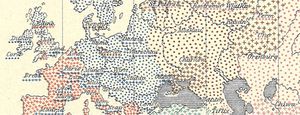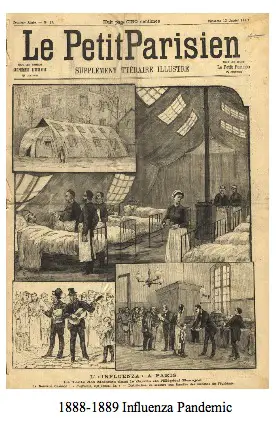How Did the 1889 1890 Flu Pandemic Affect History
The 1889-1890 influenza pandemic is relatively forgotten but it was a major pandemic and the last significant one in the 19th century. It killed over a million people, although the exact number is hard to determine. It was one of the first pandemics to also spread rapidly due to modern transport, mainly using rail, foretelling the effect of modern transport on how pandemics spread in the 21st-20th century.
Contents
The Beginning of the Pandemic
Researchers still debate the exact origin of the pandemic but it was first reported in May 1889 in Bukhara, Russia, which led to the pandemic eventually being called the 'Russian' Flu or 'Asiatic Flu'. It had spread to Saint Petersburg by November 1889 and it is at this point the virus began to rapidly spread. By December 1st, the flu had probably developed into a pandemic. By then, deaths were spiking in Saint Petersburg where it was evident the flu was abnormal relative to most years. During the winter of 1889-1890 it spread throughout the northern hemisphere through modern rail and sea transport. By December 1889 and into January 1890, most of Europe and North America had begun to show cases of the flu. By the time it reached the levels of a major flu outbreak, it only took a few weeks to spread in most developed countries. In total, it took about 5 weeks for the first cases in major cities to be reported and peak mortality. Recent research has suggested the strain that caused this flu pandemic is H3N8, which is mostly an equine influenza, suggesting that it could have originated from horses, mules, or related animals that created this flu. What stood out to doctors and researchers at the time is how the flu spread quickly and it often followed the main rail lines across Europe and North America. The was the first major flu pandemic doctors could follow using maps and daily news reports. While the virus spread to most places on the planet by the spring of 1890, its spread inland was mainly facilitated by rail that was most developed in Europe and North America. Many have now called this the first modern pandemic given the nature of how the flu spread, following major transport arteries, similar to modern pandemics (Figure 1). Mapping the spread of the virus showed how modern transport played an important role in its spread.[1]
The Spread of the Pandemic in North America
In the United States, in December 1889 the developing pandemic had become apparent as it spread across Europe. Newspapers at the time reported it and it was apparent to many public health officials the pandemic would reach the United States. However, the United States was relatively relaxed when the pandemic struck, with major port cities including New York first hit despite having time to prepare. The flu quickly spread in port cities and spread to other cities via rail lines. The flu was notable in affecting different ages young and old. Symptoms included headaches sore throat, laryngitis and bronchitis, although some reported symptoms more comparable to a common cold. Initially, political leaders and public health officials played down the spreading infections in the United States, but soon the increasing number of cases made officials acknowledge there was a problem. Newspapers were particularly calm and the local media did not think much of the pandemic, with one newspaper stating: "It is not deadly, not even necessarily dangerous.” However, by January 1890, it was clear far more people were dying than normal. The flu particularly struck those with underlying health conditions, with people with heart disease or kidney troubles most seriously affected. Soon, many people throughout the United States began to wear scarves or handkerchiefs to cover their noses and mouths. The peak of the outbreak in the United States seems to have occurred in February 1890. By the time the pandemic began to diminish, over 13,000 in the United States died, with New York leading in deaths and having 2,503 deaths. This was considered a low number considering the total deaths worldwide were about a 1 million or more. To a large extent, the United States was lucky despite being unprepared. There were second and more waves in the winter of 1890 and later in the 1890s. However, these were relatively mild, as many people had developed natural immunity by then.[2]
Impacts of the Pandemic
This pandemic was the first to be reported in near real-time across much of North America and Europe, where its progress and effect was mapped by officials. By this time, the telegraph and media in countries had developed where they began to report not only cases in their own country and cities but also in far more distant areas. Given this, many officials later criticized government responses as being very slow considering media reports about outbreaks in cities reaching distant continents in a day. This pandemic was the first to widely be reported by many different countries as well, including developing and developed countries.[3] The economic consequences were severe in some places, particularly Europe (Figure 2). However, most economies recovered within a year of the outbreak. The pandemic also claimed the lives of many well known wealthy and aristocrats in Europe. In some way, the death of prominent figures and the speed in which the influenza went through countries may have helped lead to reforms in public health witnessed in the 1890s. More attempts to create public parks, increase urban space, and improve sanitation were part of the progress witnessed in Britain and the United States in the 1890s. It was recognized that the influenza spread due to close contact between people and that sanitation, including underlying health, played a role in how well people survived infection. Interestingly, during the 1890s there was a great push towards testing for different infectious diseases. The first publicly funded health laboratories in the United States opened in the 1890s in Massachusetts and New York. Politically, the slow response by the US government, along with the panic of 1890 and raised trade tariffs, may have led to some of the electoral defeats witnessed that November for the incumbent Republicans. Congressional races led to the House being controlled by the Democrats, with Benjamin Harrison, who was president, and his party suffering great defeat. Perhaps one of the more notable long-term consequences is that many individuals who lived during this pandemic and the one that occurred in 1918 were able to obtain greater immunity to the effects of the more deadlier 1918 flu pandemic. In fact, demographic data from the flu of 1918 indicates people born after 1890 had much higher death rates. In contrast, the 1889-1890 outbreak was more even in age in terms of people affected and mostly affected people with underlying health conditions the worst.[4]
Summary
The pandemic of 1889-1890 is largely forgotten today. However, for historians, it was the first true modern pandemic because the way it spread and how it was reported. Within weeks, once the pandemic reached Saint Petersburg, Europe and North America became affected. Reporting of the pandemic was also constant, with newspapers carrying daily death tolls and infection rates, while also reporting what was happening in other countries. This enabled this pandemic to be monitored globally, for the first time, while researchers still use this pandemic to offer clues and model its spread to better understand how influenza pandemics develop. Similar to today, politicians were often slow to respond, while certain newspapers downplayed the effects of the pandemic, likening it to a more common cold rather than a deadly strain of influenza. There were some long-term benefits, including better health testing that developed soon after this pandemic, as government spending led to the creation of some of the first labs dedicated to infectious disease using public money. Politically, the pandemic killed rich and poor, resulting in the realization of greater emphasis on public spaces and the need to improve sanitation. Most governments survived politically, although many were blamed. In the United States, there were important congressional changes in power, which in part could have resulted from the slow response to the pandemic, even though there was ample warning the pandemic would hit the United States.
References
- ↑ For more on the 1889-1890 pandemic, see: Hays JN (2005) Epidemics and Pandemics: Their Impacts on Human History. Santa Barbara, Calif: ABC-CLIO.
- ↑ For more on how the 1889-1890 pandemic affected the United States, see: Ryan JR (ed.) (2009) Pandemic Influenza: Emergency Planning and Community Preparedness. Boca Raton: CRC Press.
- ↑ For more on how countries reported the pandemic, see: Dehner G (2012) Influenza: A Century of Science and Public Health Response. Pittsburgh, Pa: University of Pittsburgh Press.
- ↑ For more on the pandemic's effect, see: Raoult D and Drancourt M (eds) (2008) Paleomicrobiology: Past Human Infections. Berlin: Springer.

